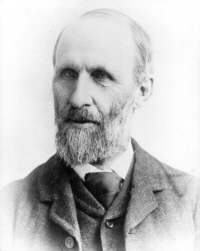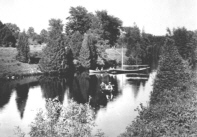

| Project Information |
| History |
| Mainstreeter |
| Churches |
| Scholasticate |
| Schools |
| Railways |
| Notables |
| After 1907 |
| 1901 Snapshot |
| Air Photo Study |
| Image Library |
| Databases |
| Search |
|
1901 Snapshot continued
|
|
| Village Life: | |
There are no definitive records that chronicle the day to
day life of the village in 1901.  Little
snippets have been found in various places but they are inadequate in terms
of an overview. However, thanks to the venerable James Ballantyne and his
daughter May, some revealing photographs are available that in many ways
chronicle village life at this time. With a little inductive thinking and
some speculation, a somewhat oblique view of this "time period"
can be had. Little
snippets have been found in various places but they are inadequate in terms
of an overview. However, thanks to the venerable James Ballantyne and his
daughter May, some revealing photographs are available that in many ways
chronicle village life at this time. With a little inductive thinking and
some speculation, a somewhat oblique view of this "time period"
can be had.
As mentioned earlier the town hall was a focal point for activity. It
was the only "public |
|
There is no record of liquor licenses being issued but there are references,
during this time, of council A Post Office and grocery store was located on Main near East Ave., run by Brigit Slattery. There were many other groceries listed in the directory along with shoemakers, bakers, a druggist, dressmakers, butchers and barbers. (John Messerschmidt started his barbershop on Second St. to later move to Hawthorne at Main where it flourished as a family business well into the 1960's.) Coal came from Ballantyne's, wood from Beaton's and there was an icehouse on Wildwood. Almost everything an average family wanted was within walking distance. What the family didn't grow in their backyard was readily available from local gardeners. |
|
 Animals
were everywhere. Many people had a horse (or two) and a buggy if well off.
Sleighs were 'de rigueur' in winter for transporting people, goods or fuel
supplies. Many people had a milk cow (or two) in their backyard. There are
numerous pictures of Mrs. Margaret Harvey's cows all over the damn place.
Council regularly admonished the village constable to enforce the Animals
were everywhere. Many people had a horse (or two) and a buggy if well off.
Sleighs were 'de rigueur' in winter for transporting people, goods or fuel
supplies. Many people had a milk cow (or two) in their backyard. There are
numerous pictures of Mrs. Margaret Harvey's cows all over the damn place.
Council regularly admonished the village constable to enforce the local bylaw for animals at large. And there were dogs and dogs and more
dogs. Everybody had dogs. With no streetlights, a part-time constable, plenty
of foxes (preying on chickens), the odd bear and lots of rats, dogs were
an essential part of village life. The village constable received 10% of
the dog license fee so that law was strictly enforced. And there was no
garbage collection, road cleaning or "stoop and scoop". What was
deposited on the roadways, stayed on the roadways until it decomposed. Coupled
with inadequate drainage (open ditches), backyard outhouses located near
the water pump, it was no wonder that council was constantly worried about
the outbreak of disease.
local bylaw for animals at large. And there were dogs and dogs and more
dogs. Everybody had dogs. With no streetlights, a part-time constable, plenty
of foxes (preying on chickens), the odd bear and lots of rats, dogs were
an essential part of village life. The village constable received 10% of
the dog license fee so that law was strictly enforced. And there was no
garbage collection, road cleaning or "stoop and scoop". What was
deposited on the roadways, stayed on the roadways until it decomposed. Coupled
with inadequate drainage (open ditches), backyard outhouses located near
the water pump, it was no wonder that council was constantly worried about
the outbreak of disease. |
|
There were no swimming pools, indoor rinks or playgrounds.
Kids played wherever they wanted to.  Everyone
used the river for swimming or fishing or boating. The canal banks were
replete with boathouses and docks for a wide variety of personal watercraft.
Apart from the odd school or family trip to Britannia Bay, most of the village
children made there own entertainment. A favourite spot was Purdy's little
house on the tracks at Main St. Fortunately this was just across the street
from Ballantyne's house and there are numerous pictures of the local kids
just hanging out and having fun and always with a dog or two. In the winter
the canal of course became an outdoor skating rink and, unlike today, kids
were actually allowed to play hockey there! Everyone
used the river for swimming or fishing or boating. The canal banks were
replete with boathouses and docks for a wide variety of personal watercraft.
Apart from the odd school or family trip to Britannia Bay, most of the village
children made there own entertainment. A favourite spot was Purdy's little
house on the tracks at Main St. Fortunately this was just across the street
from Ballantyne's house and there are numerous pictures of the local kids
just hanging out and having fun and always with a dog or two. In the winter
the canal of course became an outdoor skating rink and, unlike today, kids
were actually allowed to play hockey there!
|
|
| Social gatherings by families or groups were a mainstay village life. Picnics were major events for families especially along the canal. The Germans maintained unofficial picnic grounds along the Rideau River at the end of Beckwith Road. Every denomination celebrated Christmas at Trinity Anglican up to this year. There were regular "cultural nights" at the town hall where poetry was read along with bands, singers and local comedians. There were even "lantern shows" where slides (glass plates) of distant places were shown accompanied by lectures. | |
| One example of a 'social' was recorded in the Ste. Famille Parish History for 1902. While a few months after 1901, it offers a unique description of the kind of entertainment that took place in this time period. The description notes that the French "tricolor was in evidence, but the Union Jack was the prominent note of decoration having a good accessory in the green flag of the Irish harp". How's that for religious and ethnic tolerance. The entire article is reproduced here and it is fascinating reading. | |
| The village also had an 'elite". The Ballantynes, Lees, Grahams, Pattersons and Browns regularly met for social gatherings as evidenced by the Ballantyne photos. They had social teas, photographic expeditions, quilting bees, tennis matches and evenings of playing 'whist' in the parlour. As the wealthiest people in the village, they employed many villagers as domestics or labourers. It is doubtful then that they socialized with these people as well. The same can be concluded for the Slattery family located at the south end of the village. Compare the clothing and activities in the photographs throughout this history and it is clear that these people lived a privileged life. | |
| A Final Note:
For the most part Ottawa East in 1901 was a working community. Life was
hard, every penny counted and there were few social amenities available
to all. The community was certainly not poor as most had the basics of
life - food, shelter, safety and relatively clean drinking water, but
any extras came only with their own initiative. And that trait was in
ample supply with these people. They built everything themselves, from
a water system and roads, to churches and schools. They made use of the
river and canal for transportation and recreation. And everybody knew
everybody else. The people were, de facto, a cohesive community that together,
resisted being subsumed by the city and steadily developed their own amenities
as the century progressed. The end of the municipality came in 1907 with
annexation, but the spirit of community persisted. In the next twenty
years the community would see the building of churches, schools and businesses
that would further consolidate this feeling of separateness. That spirit
continues even today. |
|